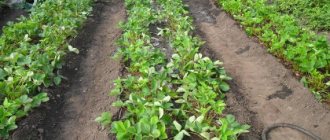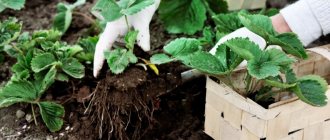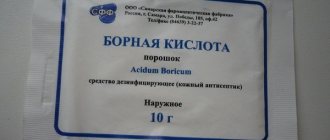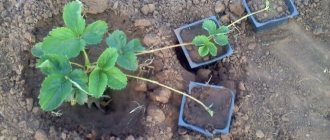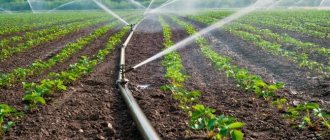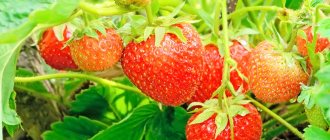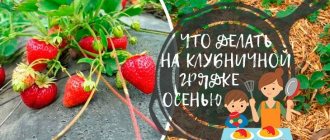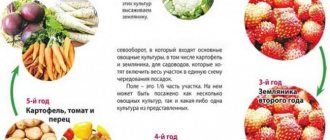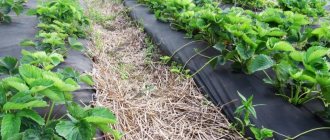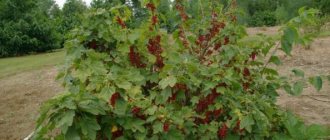Ash is a universal type of fertilizer. It is used as fertilizer for a variety of crops. It contains potassium, calcium, phosphorus and many other useful microelements necessary for plant development. Fertilizer is a natural component that is used as an additive for strawberries. The plant especially needs fertilizing in early spring. Fertilizing strawberries with ash should take place during a certain period of plant development and in accordance with the standards.
Useful properties of wood ash
Ash fertilizers have a number of advantages:
- They are easily digestible and are natural products;
- They contain many useful microelements necessary for strawberries, such as potassium, phosphorus, magnesium, boron, iron;
- The use of this particular fertilizer has more beneficial qualities than the use of expensive drugs.
Did you know! When mixing ash fertilizers with nitrogenous fertilizers, ammonia is formed. It is poorly tolerated by berries, so it is not recommended to use such fertilizers at the same time.
Another advantage of this type of additive is its long shelf life. The fertilizer is placed in a tightly closed container. Water should not get inside, otherwise the fertilizer will lose its healing properties. After the ash is added, its effect lasts for about 3-4 years.
In order to neutralize the soil from high acidity, wood ash is used. But here too there are some peculiarities. When applying the additive to areas with alkaline soil, the crop may not receive nutrients at all or absorb them in small quantities.
Fertilizing strawberries with folk remedies
Above I wrote about the only mineral fertilizer that we use on the site. All other feedings are based on folk recipes. I would like to introduce you to them.
Fertilizing strawberries with iodine and boric acid
Before we look at iodine-based supplements, let’s talk a little about it, or more precisely about its effectiveness. The fact is that this macroelement is always present in the soil. Its main source in nature is the seas and oceans, which, together with cyclones, carry it across the planet. Then, with precipitation, it falls into the soil, where it accumulates. But it varies in different soils.
Its greatest amount is in peaty soils, with an acidic reaction. The lowest in forest, podzolic soils and gray soils. The optimal amount is in chernozems. Those. If your soil is acidic, then you should not use iodine fertilizing at all, it will not be beneficial.
It's a different matter with boron. In central Russia there are practically no soils rich in natural boron. And it is very necessary for plants; plant productivity greatly depends on it, especially at the flowering stage. But its excess is also harmful, it can cause toxicosis, the leaf curls, and a yellow edge appears at the edges, then a dying edge. The volume and quality of the harvest deteriorates.
Therefore, the use of iodine and boron should be absolutely conscious, and not just because you read rave reviews about it somewhere.
As a rule, a solution of boric acid and iodine is used alternately, with an interval of 1-2 weeks. The first thing to do is feed with iodine. To do this, iodine is dissolved in water and the plants are watered at the root. Iodine take one drop per liter of water. Approximately 0.5 liters of solution is poured onto each plant.
After a week or two, but before flowering begins, fertilize with boric acid. To do this, 5 grams of acid are diluted in a glass of hot water. Then add a tablespoon of 9% table vinegar, 100 ml of glycerin and 2-3 tablespoons of 10% ammonia. The resulting volume is brought to 10 liters of water. Strawberry bushes are watered with this solution at the rate of 0.5-1 liter per 1 bush. This feeding is done once a year. In subsequent years, the application rate is reduced by 2-3 times.
An important condition for iodine and boron fertilizing is to water only in well-moistened soil; if the plants are in a weakened state, reduce the application rate several times and apply in 2-3 doses.
Instead of root fertilizing, you can fertilize the leaf, but it is important that the water splashes look more like dust, and not like large drops that flow from the leaf.
Yeast feeding
Another very common top dressing is regular baker's yeast. Of course, plants don't eat them. Simply getting into the soil, in a short period of their life they create favorable conditions both for the root system and for various microorganisms that decompose organic substances, converting them into a form that is assimilated by plants. In addition, yeast itself, when added to the soil, contains large amounts of nitrogen and protein.
For yeast feeding, 100g of compressed yeast is dissolved in 10 liters of water. Add a few teaspoons of sugar and leave for several hours to activate the yeast. It is better not to stand it for too long, so as not to start the alcohol phase. The resulting solution is used for root feeding. The consumption rate is up to half a liter per strawberry bush.
Fertilizing with yeast should only be done in early spring, or after strawberries bloom. The fact is that with such fertilizing you introduce quite a lot of easily digestible nitrogen into the soil, which the plant does not need during the flowering phase. It is also not needed in the autumn, since there is a risk of the plant starting to grow, instead of going into the resting phase before winter.
Of course, yeast cannot replace other fertilizers. Moreover, organic matter is necessary for their life in the soil. Therefore, the use of yeast is justified only when adding compost, grass clippings, humus, etc. It is very good to fertilize with ash before fertilizing yeast, since it contains almost everything necessary for their life.
How to feed with ash
Top dressing with ash is one of the most common top dressings used by gardeners and gardeners. One way or another, we burn something, and we get quite a lot of ash. Ash is the main source of potassium and especially calcium. Unfortunately, the ash itself contains trace elements in a form that is difficult for plants to extract.
But there is one simple way to convert them into another form. To do this, stir one glass of ash in one bucket of water. Then add a glass of 9% table vinegar to the bucket. You need to mix everything and let it stand for 30-60 minutes. During this time, a reaction to dissolve carbonates will take place.
This solution is diluted another 4-5 times and root feeding is carried out at the rate of 1 bush to 1 liter of solution even before the strawberries bloom.
Sometimes you can hear and read that ash can simply be scattered over bushes or dug up with soil between the beds. Of course, this can be done, but I repeat once again, the microelements in the ash are in a form that is difficult to extract, and the ash itself has a rather strong alkaline reaction.
If your soil is already alkaline or neutral, then directly introducing ash into the soil will only harm your plants. Pure ash is added to deoxidize the soil. For feeding, ash is used in a solution with acetic acid, since vinegar neutralizes its alkaline reaction.
Using ammonia
There are many legends about feeding with ammonia. Shall I try to debunk them? Ammonia, also known as ammonia, is sold in concentrations of 10% and 25%. Many claim that it is “pure” nitrogen and that such fertilizer for strawberries is almost manna from heaven.
In fact, nitrogen in a 25% ammonia solution is 200 g/kg, and in 10% it is only 80 g/kg, which you will agree is not so much. Plus, ammonia has simply monstrous volatility, and back in Soviet times, when ammonia was used in the fields as a fertilizer, when it was added to the soil, it was immediately plowed up. But later, due to its high toxicity, they completely abandoned its use in favor of mineral fertilizers such as ammonium sulfate. By the way, ammonium sulfate contains the same amount of nitrogen as 25% ammonia, but costs 10 times less.
The high volatility of ammonia can be neutralized by binding it with citric acid, thereby turning it into ammonium citrate, an organic substance beneficial to plants. But this will also increase the cost of fertilizing.
It is better and cheaper to use herbal infusions, chicken droppings and humus as fertilizers. Thus, in addition to introducing nitrogen and nitrogen-fixing microorganisms into the soil, and there are quite a lot of them in herbal infusions, you also structure the soil.
But if you still decide to feed strawberries with ammonia, do not do it during the flowering and fruiting phase. It’s better either before or immediately after.
Feeding with herbal infusions
Herbal infusion is one of the most useful fertilizers, and the cheapest. I won’t go into too much detail about this method, you can read my article about feeding cucumbers, it’s described there. I will only say that this method is not very applicable to spring feeding of strawberries, due to the lack of a sufficient amount of grass at this time.
But after the strawberries bear fruit, it will be very good to feed the bushes with this infusion.
Chicken manure fertilizer
Chicken manure is one of the best organic fertilizers. In terms of its composition, it contains twice as much nitrogen as horse or other manure.
It is very easy to use, just make a solution. For the solution, as a rule, fresh droppings are used in the proportion of 0.5 liters of droppings per 10 liters of water. Mix everything in a bucket, pour it into a watering can and apply root feeding at the rate of up to half a liter per bush.
Before feeding, it is advisable to water all the bushes with plain water. This feeding is carried out in the spring before flowering begins. Here in the Southern Urals they do this at the end of May. Such fertilizing may well replace fertilizing with phosphorus fertilizer, but the best way would be to apply both of them - phosphorus in the middle of May, and with chicken droppings at the end. The next feeding with droppings can be carried out only after flowering, for example in July.
If granular litter is used, then the solution from it is prepared as follows: take 50 liters of water per 1 kg of granules, mix everything together and mix it, then leave everything for 1 day. The feeding rate with this solution is up to 0.5 liters per 1 strawberry bush.
Humus
Humus in its pure form is used not so much as a top dressing, but to improve the soil and feed the microbiota inhabiting it. Unlike liquid fertilizers applied to the soil, humus has a prolonged effect. By spreading it as mulch around the bushes, you kill many birds with one stone: you nourish the soil biota, protect the soil from drying out, and inhibit the growth of weeds (mulch blocks light).
In addition to humus, you can use any organic material as mulch: mown grass, weeded weeds, hay and straw, and autumn leaves. The more organic matter there is in your beds, the more microorganisms there will be in the soil that provide nutrition to the plants.
Mullein infusion
Manure in its pure form is not used at all for fertilizing strawberries. When applying fresh manure, at best, we will get huge bushes with a small number of berries, which will also be watery and tasteless. And fresh manure can easily infect the soil with all sorts of pests, such as beetleworm, cutworm and wireworm. I'm not talking about helminths.
In its fresh form, manure is categorically harmful and it does not matter whose it is, cow or horse. It's another matter if you make an infusion out of it. To do this, put manure and twice as much water in a bucket or barrel. Stir and leave to ferment for 1-2 weeks, making sure to stir occasionally.
Before feeding, water the bushes with water, then the mullein solution is diluted 4-5 times with water and root feeding is carried out at the rate of 0.5 liters per bush.
Such fertilizing can be carried out only after phosphorus, since the mullein infusion contains a small amount of phosphorus and there is a risk of an imbalance of nutrients.
Bone meal fertilizer
I already wrote above that sometimes I use bone meal as a phosphorus supplement. This is good, but there is one caveat: phosphorus in bone meal is in a form that is difficult for plants to reach.
In order for plants to obtain phosphorus from bone meal, there must be phosphate-mobilizing bacteria in the soil. Such bacteria are found in the preparations Phosphatovit, Bactophosphine and others.
Bone meal is added when digging the ground at the rate of 200 grams of flour per 1 square meter. meter is a little less than a glass. This is done between the rows of strawberries. Then they water it with water and after the water they pour in preparations with bacteria.
Features of using ash fertilizers
How to fertilize strawberries? There are several rules that must be strictly followed. This will allow you to get a rich harvest of strawberries. First of all, this concerns the timing of additives. Fertilizing strawberries with ash is done at different times, which depends on the type of soil. For sandy loam and peat soil, ash additives are used only in the spring. If the site has clay, then it is recommended to apply fertilizer in the fall.
It is not difficult to determine how much ash fertilizer will be needed. It all depends on the area of the treated area. If it is small, it is enough to prepare 1-2 buckets of ash. To grow berries for sale, you will need much more of it. Approximately 15 kg of fertilizer is used per hectare of land.
Mineral fertilizers
The simplest way to feed with mineral fertilizers is complex preparations, for example: “Kemira autumn” or “Tsitovit”. Before adding mineral mixtures, carefully read the instructions on the package.
The most necessary components of feeding are potassium and nitrogen salts. They are used for dry and liquid fertilization and are certainly combined with watering the strawberry bed.
Potassium
The importance of potassium fertilizers for growing garden strawberries cannot be overestimated. Potassium prolongs the shelf life of berries, makes them sweet and very tasty.
A clear sign of a lack of potassium in the soil is the brown ends of the leaves and unusually sour strawberries. To fertilize, potassium salt is dissolved in water at a rate of 2 g per 1 liter and applied along the rows.
To feed the roots, take a mixture of 15 g (1 tbsp.) potassium salt and 20 g of nitrophoska, then dissolve in 10 liters of water. Nitrophoska is a rapidly soluble chemical compound that includes phosphorus, potassium and nitrogen. The resulting mixture is enough for 10 strawberry bushes.
Watch a video about applying a complex preparation that includes potassium, phosphorus and nitrogen:
To replenish the soil with nitrogen, you need urea or ammonium nitrate. Nitrogen accelerates the growth of berries, gives a rich red color and improves the gastronomic qualities of strawberries. But, subject to the correct dosage of fertilizer.
Excess nitrogen will reduce the sugar content of the fruit. The main indicators of nitrogen deficiency are stunted and pale leaves, small fruits, and weak plant tendrils. To apply under the bush, urea is diluted in the proportions of 1 tbsp. l. per 10 liters of water, this is enough for 20 strawberry bushes.
A mixed solution is prepared from industrial and organic fertilizers:
- water 10 l;
- ash 1 tbsp.;
- mullein 1 l;
- superphosphate 2 tbsp. l.
Use to fertilize between rows at a rate of 10 liters per 1 square meter. m plot. Combined mixtures are prepared immediately before application to the soil.
Hydrogen peroxide is also used to fertilize garden strawberries. The extract effectively increases the level of oxygen in the ground air, which helps plants absorb nutrients. To prepare the solution, take:
- water 1 l;
- hydrogen peroxide (3%) 2 tbsp. l.
Use 200 ml per bush for root feeding.
Mineral fertilizers primarily affect the plants themselves, and do not improve the quality of the soil. In weak and depleted areas, it is recommended to combine mineral fertilizing with the addition of organic matter.
Compared to organic fertilizers, mineral fertilizers do not have an unpleasant odor and are more convenient to use. But their use requires strict adherence to recommended standards.
How to prepare ash solution
Ash fertilizers are universal and suitable for all types of crops. If gardeners do not have enough time to prepare various types of additives, they often use ash to topcoat various vegetables and berries. To prepare the miracle solution, you need to do the following:
- Take a 10 liter bucket.
- Fill it with water.
- Add 1 cup wood ash and stir.
It is necessary to water at the root of each plant. In addition, the ash is used in the preparation of compost. This will significantly increase the amount of useful substances that are formed in the future.
Composition and benefits of ash for strawberries
The composition of combustion products also differs depending on the type. Thus, wood ash, which is most often used for fertilizing on private farms, contains the most calcium: about 30 - 35%. The content of the same substance in cereal straw, buckwheat and corn tops is reduced to 4 - 8%, in sunflower plant residues - to 19%.
Due to its high calcium content, ash is often used to deoxidize the soil. However, in alkaline and slightly acidic soils, the use of wood ash with a high calcium content can lead to improper absorption of nutrients by plants. Fertilizing will be useless. It is better to feed strawberries with wood ash on acidic soils. On alkaline soils, combustion products of various cereals and sunflowers are usually used.
In addition to calcium, the composition contains potassium in large quantities. This element is incredibly important for strawberries, since if it is deficient, the berry becomes unsweetened, deformed and small. The number of ovaries also decreases, which negatively affects the overall yield. Wood contains about 10% of this substance; in cereal crops this figure can be higher - up to 20%. But in the ash of sunflower and buckwheat the potassium content is the highest: 30 - 40%.
It is believed that phosphorus is present in large quantities in the ash composition. Yes, this element exists, but its content usually does not exceed 4%. Ash of any type contains magnesium, sodium and chlorine in the same amount. All these elements are beneficial and have a positive effect on the development of strawberries.
Phosphorus is responsible for the development of the root system. Magnesium increases resistance to adverse factors and increases productivity. Sodium and chlorine have disinfectant properties. The last two elements are required by strawberries in minimal quantities. Exceeding the norms of chlorine and sodium leads to inhibition of bush growth, and therefore, when adding ash, you must strictly adhere to the composition of the fertilizer and the application schedule.
When to fertilize strawberries
It is necessary to feed strawberries 3 times during the growing season. The first will be needed in the spring, the second - after harvesting, the last - during preparation for winter. When the strawberries begin to bloom leaves, wood ash is poured under the bush and the soil is thoroughly loosened. Fed bushes develop better and shoots appear faster.
During flowering, bushes are often sprayed. Use preparations containing boron and zinc. When the strawberry berries are harvested, feed them a second time. The last time is necessary to stimulate the formation of new roots and leaves. This happens during the period of preparation for winter.
Did you know! For fertilizing, only wood ash is used. The remainder after burning garbage or household waste is not used.
Fertilize in spring or fall
How to feed strawberries with ash:
- Feeding with ash. Once after planting the strawberries, sprinkle the fresh bushes directly with the greens with ash. This will prevent diseases from occurring and fill the earth with useful substances. Which promotes active plant growth. Fertilizers should be applied after the soil is well moistened.
- Fertilizing with ammonia. 2 feeding is carried out two weeks after the first. You need 2 tbsp. Dilute ammonia in 7 liters of water and pour well over the strawberries along with the herbs. This will also prevent the occurrence of bacterial diseases and will promote friendly flowering and saturation of the earth with nutrients.
- Fertilizing with green fertilizers. In the summer, after picking strawberries, it is good to water the bushes with green fertilizers. To do this, add warm water to the grass from the garden and place it in the sun to ferment. After a week, the fermented slurry is ready for use. You need to dilute 1 liter of liquid in a bucket of water and pour it under each strawberry bush.
- Autumn feeding. In autumn, an important component is feeding with ash and ammonia. Fertilizers are applied to each bush by alternating every 2 weeks. This contributes to the formation of new flower buds and a bountiful harvest for the next year.
Video:
Why do you need to feed strawberries in the spring?
After a long winter, strawberries need nutrients. They are necessary for the normal growth and development of the plant, as well as for the bushes to become stronger and gain strength for good fruiting. Nitrogen supplements are used for feeding at this time. They contribute to the growth of greenery, which is necessary for the further development of the plant. At this time, it will be best to feed strawberries with urea. The bushes also need supplements containing potassium and phosphorus.
Strawberries should be fertilized when the snow melts. During this period, the soil is moist, which helps the roots quickly absorb supplements. In order for the earth to warm up, it is necessary to remove old leaves, mulch, and trim off excess. If granular substances are used, they are embedded in the soil. When applying fertilizer for strawberries in the spring, it is important to follow the norms, since an excess of nitrogen only contributes to the growth of leaves, and there are fewer berries.
What to feed strawberries
So, for the sake of understanding, let’s say it again: the main fertilizer for strawberries is phosphorus. Not nitrogen and not potassium, but phosphorus. And it is with this fertilizer that you need to carry out the first spring feeding. The best time to apply fertilizer is when the soil warms up to +15 degrees.
It is almost pointless to apply such fertilizing as soon as the snow melts. The root system is not yet capable of extracting nutrition from the soil; it does not work in cold soil. But there is a risk that with the first rains, the fertilizing we applied will go to a depth where the roots cannot reach it even in summer.
Phosphorus feeding is done as follows. Pour one kilogram of double superphosphate into 5 liters of boiled water and leave overnight. Shake and stir occasionally. In general, we try our best to dissolve everything.
The next day, add 0.5 liters of ordinary 9% table vinegar to the phosphorus infusion. The vinegar will cause the calcium phosphate to convert into its more soluble form, calcium dihydrogen phosphate, a substance that is readily absorbed by plants.
It should be noted that simple or double superphosphate contains a significant amount of soluble phosphate, but when it enters the soil and combines with natural calcium ions, they transform into forms inaccessible to plants. And acetic acid binds calcium ions and other impurities, which cause a deterioration in the absorption of phosphorus by plants.
Then the resulting solution is brought to 10 liters. After this, dilute 1 liter of solution in 10 liters of water and water it at the rate of 0.5 liters for each bush. Thus, from 1 kg of double superphosphate we will prepare 100 liters of fertilizer, which is enough for 200 bushes. This feeding is carried out once per season, either in autumn or spring.
If you don’t like mineral fertilizers and are a fan of everything natural, double superphosphate can be replaced with bone meal. But not everything is so simple, and I will write about this below.
Separately, it is necessary to say about nitrogen fertilizing. Strawberries, in their development, like all plants, require a balance in nutrition and nitrogen must be added very carefully. Based on this, in the year when plants bear fruit, the spring application of nitrogen fertilizers should be limited, since dense plantings and increased growth of vegetative mass make plants more susceptible to gray rot and reduce the quality of strawberries.
Feeding during flowering
Fertilizing strawberries with ash is not used during this period. The following supplements will help you achieve maximum flowering:
- Boric acid;
- Potassium sulfide;
- Potassium permanganate.
The plant is treated when it begins to bloom. The exact timing depends on the region of growth. It is important to apply fertilizing on time. If fertilizers are applied early, they simply will not work. If it is late, the harvest will be significantly smaller.
Did you know! It is possible to achieve an increase in yield by almost 25-30%. To do this, you need to spray the bushes during flowering. This also helps to increase the mass of berries.
Adding additives during the fruiting period
Organic fertilizers will help increase the yield. As a rule, the first wave of berries is the largest. After this, the berries become smaller. To avoid this, add an infusion of mullein, bird droppings or compost.
It is recommended to use only natural additives during the fruiting period. Other means can lead to the accumulation of nitrates in berries, as well as a deterioration in the taste of the berries.
Fertilizing strawberries with ash
